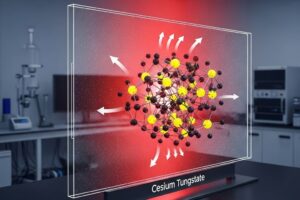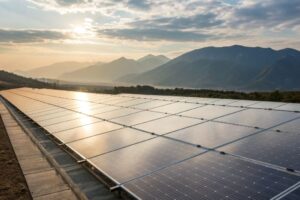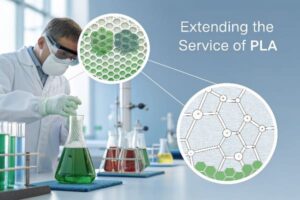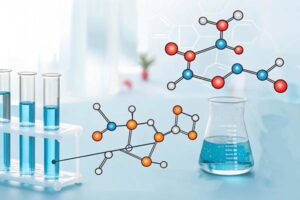Are you in the solar industry, constantly seeking to improve the longevity and performance of photovoltaic modules? Do you know that the right additives can make a significant difference in the durability of your solar panels? Understanding these key additives for EVA and POE encapsulants is crucial for module reliability.
Key additives for EVA and POE encapsulants are specialized chemicals that significantly improve the long-term performance, UV resistance, adhesion, and thermal stability of solar module encapsulants. These additives are essential for protecting sensitive solar cells from environmental degradation, ensuring the module's efficiency and lifespan.
Langyi have witnessed firsthand the evolution of solar technology. When we started, EVA was the dominant encapsulant. Everyone focused on how to make it last longer under harsh conditions. What we learned quickly was that the encapsulant, though seemingly just a clear film, is actually the unsung hero of a solar panel. It encapsulates and protects the delicate solar cells. However, its effectiveness heavily relies on the right combination of additives. Langyi recognized this early. We dedicated ourselves to developing sophisticated additive solutions for the solar backsheet film industry, working closely with top encapsulant companies to push the boundaries of module durability.
What is Encapsulant EVA?
Are you wondering what "EVA" means in the context of solar panels? You might think it is just a type of plastic. It plays a critical role in the solar module's integrity.
Eva encapsulant film stands for Ethylene Vinyl Acetate, a transparent copolymer film widely used as a crucial encapsulating material in photovoltaic (PV) modules. Its primary function is to protect the fragile solar cells from environmental factors like moisture and dust, provide electrical insulation, and mechanically bond the cell assembly to the top glass and backsheet.**

When we visit solar module manufacturing plants, we always emphasize the importance of EVA. Many people assume the glass and cells are the most critical parts. However, without a reliable encapsulant, the module's lifespan would be severely compromised. EVA is chosen for its excellent transparency, allowing maximum sunlight to reach the cells. It also has good adhesion properties, ensuring everything stays together. It provides electrical insulation, preventing short circuits. Moreover, it cushions the cells against mechanical stress. However, standard EVA is susceptible to UV degradation and thermal aging. This can lead to yellowing, delamination, and power loss over time. This is where additives become vital. They extend EVA's useful life in challenging outdoor environments. Langyi has been among the earliest companies in China to develop a series of additives specifically tailored for the intricate demands of the solar industry. We understand that the PV module is exposed to extreme conditions for decades. Therefore, the encapsulant must be incredibly robust.
| Property | Description | Importance in PV Modules |
|---|---|---|
| Transparency | High light transmittance to solar cells | Maximizes power generation efficiency |
| Adhesion | Bonds glass, cells, and backsheet | Prevents delamination, ensures structural integrity |
| Electrical Insulation | Prevents current leakage and short circuits | Ensures safety and module performance |
| UV Resistance | Withstands prolonged exposure to sunlight | Prevents yellowing and degradation over module lifespan |
| Thermal Stability | Maintains properties under high operating temperatures | Prevents material breakdown and power loss |
What is the Difference Between EVA and POE Encapsulant?
Are you confused about choosing between EVA and POE for your solar modules? You might think they are interchangeable. They have distinct properties and applications.
The main difference between EVA (Ethylene Vinyl Acetate) and POE (Polyolefin Elastomer) encapsulants lies in their chemical structure and resulting properties. While EVA is a copolymer with better adhesion and lower cost, POE is a more advanced polyolefin-based material offering superior moisture barrier1 properties, PID (Potential Induced Degradation) resistance, and UV stability, making it ideal for high-humidity or advanced module designs.

At Langyi, we often help our clients navigate the choice between EVA and POE. For years, EVA was the standard. It offers reliable performance for most crystalline silicon modules, especially in moderate climates. Its good adhesion and lower cost make it attractive. However, with the rise of bifacial modules2, N-type cells3, and modules deployed in high-humidity regions, the limitations of EVA became apparent. EVA contains acetic acid after degradation, which can corrode sensitive cell metallization and contribute to PID.
POE, being a polyolefin, is inherently more resistant to moisture ingress and has excellent volume resistivity, making it less prone to PID issues. This is especially critical for modules involving sensitive cell technologies or deployed in challenging environments. POE also typically exhibits better long-term UV stability and thermal aging resistance without relying as heavily on additives as EVA does. Though often more expensive, POE's superior protection properties can lead to a longer module lifespan and higher energy yield in demanding applications. As a supplier of additives, we develop solutions that cater to both materials, understanding their unique chemical characteristics and performance requirements.
| Feature | EVA Encapsulant | POE Encapsulant |
|---|---|---|
| Chemical Structure | Ethylene Vinyl Acetate copolymer | Polyolefin Elastomer |
| Main Advantages | Good adhesion, lower cost, widespread use | Superior moisture barrier1, PID resistance, UV stability |
| Main Disadvantages | Prone to yellowing, acetic acid generation, PID risk | Higher cost, sometimes trickier processing |
| Typical Applications | Standard crystalline silicon modules | Bifacial, N-type, thin-film, high-humidity environments |
| Moisture Permeability | Higher | Lower |
| PID Resistance | Moderate | Excellent |
What is the Difference Between EVA and EPE?
Are you hearing about "EPE" in addition to "EVA" in the solar industry? You might wonder if it's just a new name for the same thing. EPE represents an evolution in encapsulant technology.
EPE encapsulant refers to a co-extruded film combining layers of EVA and POE, typically with an inner core of POE sandwiched between two outer layers of EVA. This hybrid structure aims to leverage the best properties of both materials: the superior moisture barrier and PID resistance of POE in the core, combined with the excellent adhesion and processing ease of EVA on the outer surfaces.
In recent years, the solar industry has been incredibly innovative, and EPE encapsulants are a perfect example of this. When manufacturers realized the need for improved moisture resistance and PID performance beyond what standard EVA could offer, but didn't want to completely abandon EVA's benefits, EPE emerged as a clever solution. From Langyi's perspective, this means we need to provide highly effective additive packages that are compatible with both EVA and POE layers within the same film. The POE core of EPE provides the critical barrier against moisture and prevents the degradation mechanisms like PID that are often linked to moisture ingress.
Meanwhile, the outer EVA layers ensure strong adhesion to the glass and backsheet, which is crucial for module reliability and ease of manufacturing processes like lamination. This hybrid approach allows module makers to achieve enhanced performance, particularly for advanced cell technologies, while maintaining good manufacturing throughput. It’s a smart way to get the best of both worlds, and it requires a nuanced understanding of additive chemistry to ensure all layers perform optimally and synergistically.
| Feature | EVA Encapsulant (Mono) | EPE Encapsulant (Co-extruded) |
|---|---|---|
| Structure | Single layer of EVA | Multi-layer (e.g., EVA/POE/EVA) |
| Main Benefit | Cost-effective, good adhesion | Combines adhesion with moisture/PID resistance |
| PID Resistance | Moderate | Enhanced (due to POE core) |
| Moisture Barrier | Moderate | Superior (due to POE core) |
| Adhesion to Glass/Backsheet | Excellent | Excellent (EVA outer layers) |
| Cost | Lower | Higher than mono-EVA, lower than mono-POE |
| Application Focus | Standard modules | Advanced modules, high-humidity environments |
Additives to Improve the Quality of EVA and POE Encapsulant?
Are you wondering what specific compounds are added to EVA and POE to make them perform so well in solar panels? You might think it is just the base resin. A blend of specialized additives makes all the difference.
To significantly improve the quality, durability, and long-term performance of EVA and POE encapsulants, a precise blend of additives is critical. These typically include UV stabilizers, antioxidants, and adhesion promoters. Beyond these common types, specialized additives such as acid removers4 and anti-PID agents5 play a crucial role in addressing specific degradation mechanisms.

At Langyi, our expertise truly shines in the development of these crucial additive packages. We understand that a solar module needs to perform reliably for 25-30 years in diverse and often harsh climates. This demands encapsulants that go far beyond the properties of the raw EVA or POE resin. For instance, UV stabilizers are paramount. They prevent the encapsulant from yellowing and becoming brittle under constant sunlight, which would otherwise reduce light transmission and bonding strength. Antioxidants are equally important. They scavenge free radicals formed by heat and UV exposure, preventing chain scission and degradation of the polymer. Adhesion promoters ensure a strong, long-lasting bond between the encapsulant and the glass, cells, and backsheet, preventing delamination. Delamination is a major cause of module failure. These are widely known.
However, beyond these, we focus on more specialized additives. For EVA, acid removers4 are critical. During the degradation of EVA, acetic acid can be released. This acid can corrode the metallic contacts of solar cells and other sensitive module components. Acid removers neutralize this acid, protecting the cells and preventing related failures.
For both EVA (though less critical) and especially POE, anti-PID (Potential Induced Degradation) additives are extremely important. PID occurs when a voltage difference between the solar cells and the grounded module frame drives ion migration. This leads to shunt paths and power loss. Anti-PID additives work by inhibiting this ion migration or by improving the electrical resistivity of the encapsulant. This helps maintain the module's performance, especially in high-voltage systems and humid environments. We have seen how these specialized additives can translate into years of extended module life. Our team meticulously designs these additive blends. We consider the specific requirements of both EVA and POE chemistries. We also consider the end application. We supply these tailored solutions to top encapsulant companies both in China and overseas, proud to contribute to the global renewable energy movement.
| Additive Type | Function | Impact on Encapsulant |
|---|---|---|
| UV Stabilizers | Absorbs/scavenges UV radiation | Prevents yellowing, maintains transparency, extends lifespan |
| Antioxidants | Inhibits oxidation, scavenges free radicals | Prevents polymer degradation, maintains mechanical properties |
| Adhesion Promoters | Enhances bonding to glass, cells, and backsheet | Prevents delamination, improves module reliability |
| Peroxide (for EVA) | Initiates crosslinking during lamination | Increases EVA stiffness, improves heat resistance |
| Processing Aids | Improves melt flow and lamination efficiency | Ensures uniform film, reduces manufacturing defects |
| Acid Removers (for EVA) | Neutralizes acidic byproducts of EVA degradation | Prevents cell corrosion, extends module life |
| Anti-PID Agents (for POE) | Improves volume resistivity, inhibits ion migration | Enhances resistance to Potential Induced Degradation |
Conclusion
Additives are critical for boosting EVA and POE encapsulant performance. They extend solar module life by enhancing UV, thermal, and moisture resistance. Specialized acid removers4 and anti-PID agents5 are also vital for long-term reliability.
Learn about the importance of moisture barriers in protecting solar modules from environmental damage. ↩
Discover the benefits of bifacial modules in maximizing solar energy capture. ↩
Learn about N-type cells and their advantages in solar technology. ↩
Discover how acid removers protect solar cells from degradation caused by EVA. ↩
Understand the function of anti-PID agents in enhancing solar module performance. ↩






